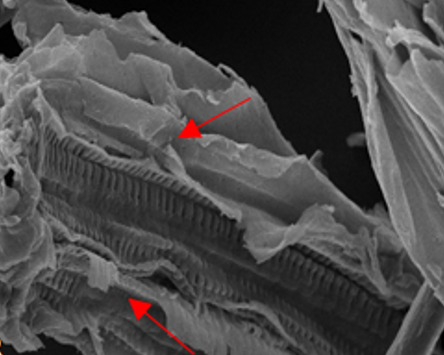THE EFFECTIVENESS OF USING DEEP EUTECTIC SOLVENT ON DELIGNIFICATION OF WHEAT STRAW
UDC 66.092
Abstract
The research is dedicated to study the efficiency of lignin extraction using deep eutectic solvent (DES) composed of choline chloride and oxalic acid (0.75 : 1). The experiment was conducted in the temperature range 80–110 °С. The cellulose-enriched fraction (technical cellulose), as well as lignin and hemicellulose fractions were isolated from the treatment products. Evaluation of the effectiveness was carried out by the yield of lignin fraction and degree of delignification. It was found that increasing the temperature up to 110 °С caused the increase of delignification of wheat straw degree to 83%, and yield of lignin fraction up to 15.5% dry mass. Along with delignification, removal of hemicellulose from straw biomass in this temperature range and, as a consequence, an increase in the cellulose content of the technical cellulose fraction was observed. The structural changes of the technical cellulose were analyzed using IR-spectroscopy and scanning electron microscopy methods. The obtained SEM-images allowed to clearly trace morphological changes of structure and to draw conclusions about the effectiveness using DES on breaking the bonds between the biopolymers of the lignocarbohydrate complex of wheat straw.
Downloads
Metrics
References
Singh A., Prajapati P., Vyas S., Gaur V.K., Sindhu R., Binod P., Kumar V., Singhania R.R., Awasthi M.K., Zhang Z., Varjani S. Bioenergy Research, 2023, vol. 16, pp. 105–122. https://doi.org/10.1007/s12155-022-10440-2.
Zhang J., Yang J., Zhang H., Zhang Z., Zhang Y. BioResources, 2021, vol. 16(2), pp. 4523–4543. https://doi.org/10.15376/biores.16.2.Zhang.
Ayodele B.V., Alsaffar M.A., Mustapa S.I. Journal of Cleaner Production, 2020, vol. 245, 118857. https://doi.org/10.1016/j.jclepro.2019.118857.
Kumar B., Bhardwaj N., Agrawal K., Chaturvedi V., Verma P. Fuel Processing Technology, 2020, vol. 199, 106244. https://doi.org/10.1016/j.fuproc.2019.106244.
Den W., Sharma V.K., Lee M., Nadadur G., Varma R.S. Frontiers in Chemistry, 2018, vol. 6, pp. 1–23. https://doi.org/10.3389/fchem.2018.00141.
Yevstaf'yev S.N., Khoang K.K. Khimiya rastitel'nogo syr'ya, 2016, no. 4, pp. 27–34. https://doi.org/10.14258/jcprm.2016041308. (in Russ.).
Cristino A.F., Logan D., Bordado J.C., Galhano dos Santos R. Processes, 2021, vol. 9, 1214. https://doi.org/10.3390/pr9071214.
Ocreto J.B., Chen W.-H., Rollon A., Ong H.C., Petrissans A., Petrissans M., De Luna M.D.G. Chemical Engineering Journal, 2022, vol. 445, 136733. https://doi.org/10.1016/j.cej.2022.136733.
Vigier K.D.O., Chatel G., Jérôme F. Chem. Cat. Chem., 2015, vol. 7, pp. 1250–1260. https://doi.org/10.1002/cctc.201500134.
Chen Y., Mu T. Green Energy & Environment, 2019, vol. 4, pp. 95–115. https://doi.org/10.1016/j.gee.2019.01.012.
Vanda H., Dai Y., Wilson E.G., Verpoorte R., Choi Y.H. Comptes Rendus Chimie, 2018, vol. 21, pp. 628–638. https://doi.org/10.1016/j.crci.2018.04.002.
Plotka-Wasylka J., de la Guardia M., Andruch V., Vilkova M. Microchemical Journal, 2020, vol. 159, 105539. https://doi.org/10.1016/j.microc.2020.105539.
Abbott A.P., Capper G., Davies D.L., Rasheed R.K., Tambyrajah V. Chemical Communication, 2003, pp. 70–71.
Liu Y., Guo B., Xia Q., Meng J., Chen W., Liu S., Wang Q., Liu Y., Li J., Yu H. ACS Sustainable Chemistry & Engi-neering, 2017, pp. 7623–7631. https://doi.org/10.1021/acssuschemeng.7b00954.
Lee K.M., Hong J.Y., Tey W.Y. Cellulose, 2021, vol. 28, pp. 1513–1526. https://doi.org/10.1007/s10570-020-03598-5.
Li W., Amos K., Li M., Pu Y., Debolt S., Ragauskas A.J., Shi J. Biotechnology for Biofuels, 2018, vol. 11, 304. https://doi.org/10.1186/s13068-018-1305-7.
Ci Y.-H., Yu F., Zhou C.-X., Mo H., Li Z-Y., Ma Y.-Q., Zang L.-H. Green Chemistry, 2020, vol. 22, pp. 8713–8720. https://doi.org/10.1039/D0GC03240A.
Malaeke H., Housaindokht M.R., Monhemi H., Izadyar M. Journal of Molecular Liquids, 2018, pp. 193–199. https://doi.org/10.1016/j.molliq.2018.05.001.
Hakkinen R., Abbott A. Green Chemistry, 2019, vol. 21, pp. 4673–4682. https://doi.org/10.1039/C9GC00559E.
Obolenskaya A.V., Yel'nitskaya Z.P., Leonovich A.A. Laboratornyye raboty po khimii drevesiny i tsellyulozy: uchebnoye posobiye dlya vuzov. [Laboratory work on the chemistry of wood and cellulose: a textbook for universities]. Moscow, 1991, 320 p.

Copyright (c) 2024 chemistry of plant raw material

This work is licensed under a Creative Commons Attribution 4.0 International License.

This work is licensed under a Creative Commons Attribution 4.0 International License.
The authors, which are published in this journal, agree to the following conditions:
1. Authors retain the copyright to the work and transfer to the journal the right of the first publication along with the work, at the same time licensing it under the terms of the Creative Commons Attribution License, which allows others to distribute this work with the obligatory indication of the authorship of this work and a link to the original publication in this journal .
2. The authors retain the right to enter into separate, additional contractual agreements for the non-exclusive distribution of the version of the work published by this journal (for example, to place it in the university depository or to publish it in a book), with reference to the original publication in this journal.
3. Authors are allowed to post their work on the Internet (for example, in a university repository or on their personal website) before and during the review process of this journal, as this may lead to a productive discussion, as well as more links to this published work.











